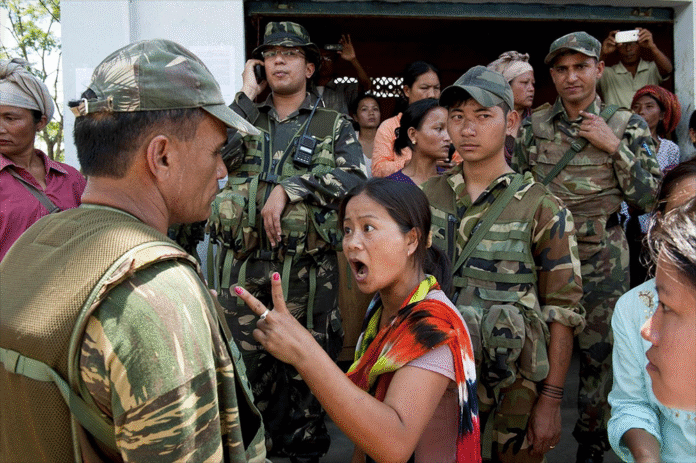It has been over two years now since the ethnic violence began in Manipur, sparked by competing claims over Scheduled-Tribe status and land rights. This escalated into valley–hills polarisation, primarily between the Meitei community in the Imphal Valley and the Kuki-Zo groups in the hill districts. By mid-2025, the conflict had claimed around 260 lives and displaced over 60,000 people, many still living in relief camps. The state’s law and order structure collapsed, resulting in the resignation of Chief Minister N Biren Singh in February 2025 and the imposition of President’s Rule later that month, which remains in effect and has been extended from August 13, 2025. Amid mounting tensions, recent developments, including the renewal of the tripartite Suspension of Operations (SoO) agreement and the reopening of National Highway-2 (NH-2), set the stage for an upcoming visit by Prime Minister Narendra Modi in mid-September 2025. Could this visit mark a turning point? A question which may not have many answers.
Genesis of the Conflict
The ultimate trigger, a 2023 push by Meitei groups for ST status, intensified pre-existing anxieties. Kuki-Zo communities feared demographic dilution and political marginalisation. Historical administrative disparities and ethnic grievances quickly transformed into violent confrontation.
Major Issues between Kukis and Meiteis
Demand for Scheduled Tribe (ST) Status by Meiteis
The Meitei community, which forms about 53% of Manipur’s population, has been seeking Scheduled Tribe status to gain constitutional protections for their land, jobs, and education. Currently, ST status benefits mainly tribal groups in the hills, including Kukis and Nagas. Kukis fear that granting ST status to Meiteis would erode tribal protections, open up hill lands for purchase by valley residents, and alter the demographic and political balance.
Land Ownership and Hill-Valley Divide
Under the law (Manipur Land Revenue and Land Reforms Act, 1960), valley residents cannot buy land in hill districts, but hill residents can own land in the valley. Kukis perceive Meitei ST demands as a way to circumvent this protection and expand into hill areas. Meiteis argue that their valley areas are overcrowded, and access to hill land is necessary for economic growth.
Political Representation and Autonomy
Hill areas enjoy Autonomous District Councils (ADCs), giving tribal groups limited self-governance under the Sixth Schedule model (though Manipur itself is not fully under the Sixth Schedule like Mizoram). Kukis demand greater autonomy or even separate administration after the 2023–25 violence, fearing permanent marginalisation under a Meitei-dominated state government. Meiteis oppose this, seeing it as a threat to Manipur’s territorial integrity.
The Meitei community, comprising 53% of Manipur’s population, seeks Scheduled Tribe status to gain constitutional protections for their land, job opportunities and educational access. Currently, ST status benefits tribal groups in the hills, including Kukis and Nagas. Kukis fear that granting ST status to Meiteis would erode tribal protections, open up hill lands for purchase by valley residents, and alter the demographic and political balance
Immigration and ‘Illegal Settlers’ Debate
Meiteis accuse Kukis of shielding illegal immigrants from Myanmar (especially after the 2021 coup in Myanmar) and allowing populations to swell in border districts like Churachandpur and Tengnoupal. Kukis argue that many of these people share ethnic ties and flee conflict, accusing the state of ethnic profiling and forced eviction in the name of forest and immigration drives.
Drug Trafficking and Poppy Cultivation Allegations
Manipur borders the Golden Triangle (Myanmar–Laos–Thailand), a hub for the narcotics trade. The state government claims poppy cultivation in hill areas fuels drug trafficking, with alleged involvement of Kuki insurgent groups. Kukis counter that anti-drug operations have been used as pretexts to evict tribal villages and criminalise their community.
Insurgent Groups and Militarisation
Kuki insurgent groups under the Suspension of Operations (SoO) agreement claim to protect tribal interests but face allegations of extortion and parallel governance. Meitei armed groups (e.g., Arambai Tenggol) emerged recently, vowing to defend the valley community. The proliferation of armed actors on both sides has fuelled cycles of violence and revenge attacks.
AFSPA, Policing, and Human Rights
The Armed Forces (Special Powers) Act (AFSPA) gives sweeping powers to the military in ‘disturbed areas’, mostly in hill districts. Kukis accuse state forces of bias towards Meiteis, citing uneven disarmament drives and selective security operations. Meiteis argue that Kuki militants exploit border terrain and cross-border sanctuaries to sustain conflict.
Economic Marginalisation and Development Gaps
Kukis claim hill districts lag in road networks, schools, and health infrastructure due to neglect by Imphal-centric governments. Meiteis counter that central funds for tribal welfare often get cornered by elite tribal groups or militant outfits, limiting genuine development.
Two years of conflict have displaced tens of thousands, segregating villages and neighbourhoods along ethnic lines. Kukis feel the state machinery failed to protect them, while Meiteis highlight attacks on their settlements near hill boundaries. Both communities now live with psychological trauma and mutual distrust, complicating reconciliation
Humanitarian and Identity Concerns
Two years of conflict have displaced tens of thousands, segregating villages and neighbourhoods along ethnic lines. Kukis feel the state machinery failed to protect them, while Meiteis highlight attacks on their settlements near hill boundaries. Both communities now live with psychological trauma and mutual distrust, complicating reconciliation.
Separate Administration vs Territorial Integrity
Since 2023, many Kuki groups have demanded ‘separate administration’ or even a Union Territory carved out of Kuki-majority areas. Meiteis and the state government strongly oppose any division of Manipur, seeing it as a threat to the state’s unity.

The Role of Non-State Armed Groups
Paramilitary formations, such as the Meitei Arambai Tenggol, Meitei Leepun and Kuki-Zo insurgent entities, filled a security vacuum. Their presence fostered entrenched zones of control, severely limiting state authority. Adding complexity were cross-border flows from Myanmar, a state of regional free-for-all where arms and combatants move easily.
Governance Breakdown and Legal Responses
Biren Singh’s resignation and the imposition of President’s Rule in February 2025 signified federal takeover of the state’s administration, a move both hailed as necessary for stability and criticised as undermining democratic norms. AFSPA remains in force across much of the state, extended again in early 2025, raising human-rights concerns even as the Central government sees it as essential to maintaining order.
Humanitarian Fallout
Protracted displacement has left tens of thousands in camps, with limited access to healthcare, education, or livelihood support. Reports highlight acute psychological distress among displaced children and adults alike, further undermining prospects for peace.
The Signals: Signs of Change on the Ground
Two recent developments offer hope:
Renewal of the tripartite SoO agreement, reaffirming Manipur’s territorial unity and setting terms for armed group behaviour.
Reopening of NH-2, the main supply artery, which critical for both the economy and relief operations. These moves appear calibrated to lay groundwork ahead of the PM’s upcoming visit, reported to be scheduled around September 13, 2025, with accompanying security preparations like ‘no-drone’ zones.
Potential Impact of the Prime Minister’s Visit
The visit brings symbolic and practical weight. Here’s how it could shape progress.
The imposition of President’s Rule signified federal takeover of the state’s administration, a move hailed as necessary for stability and criticised as undermining democratic norms. AFSPA remains in force across much of the state, extended again in early 2025, raising human-rights concerns even as the Central government sees it as essential to maintaining order
De-escalation and Normalisation
-
Legalisation of the NH-2 reopening, backed by institutional mechanisms: joint coordination cells, safe-corridor protocols, and emergency hotlines
-
Formalisation of SoO terms: GPS-tagged arms, biometric registries, compliance audits, and clear, enforceable penalties for breaches
-
Security baselines: aerial restrictions, enhanced intelligence coordination, and rapid response teams to deter spoilers
Humanitarian and Psychological Support
-
Roll-out of a rehabilitation and housing package, with clearly published beneficiary lists, monitored delivery, and third-party oversight
-
Introduction of mobile mental-health clinics, staffed by local professionals, delivering PTSD and stress-management support across camps and return sites
Such interventions could mitigate the material and emotional trauma and signal inclusive governance.
Political Roadmap
Two possible transitions:
-
A. Early restoration of elected governance, conditional upon security benchmarks
-
B. Governor-led “Peace and Reconstruction Council”, with representation from both communities and civil society, tasked to co-design relief and reconstruction, potentially winding up in favour of elections once stability returns
Security Signalling and AFSPA Review
While outright AFSPA repeal is unlikely, the PM may announce district-based review mechanisms, with phased declassification in low-incident areas, a necessary political olive branch. Simultaneously, strengthened border management through Assam Rifles and inter-state coordination could dampen external spoilers.
Narrative Reset and Acknowledgement
A public address acknowledging loss on both sides, citing displacement figures, and committing to equality across communities could provide emotional resonance, especially if delivered in both the valley (Imphal) and a hill district (e.g., Churachandpur).
The repeal of AFSPA is highly unlikely, but Prime Minister Modi may announce district-based review mechanisms, with phased declassification in low-incident areas, a necessary political olive branch. Simultaneously, strengthened management of the border through Assam Rifles and inter-state coordination could dampen external spoilers
Risks & Caveats
-
Spoiler actions timed around the visit—countered only with localised enforcement and communication breakdown
-
Loopholes in SoO implementation, e.g., shell camps, misappropriated funds, or unauthorised arms, damaging credibility
-
Delayed humanitarian delivery, especially in mixed-return areas, risking disillusionment
-
Overpromising on AFSPA, risking backlash if security benchmarks aren’t met or dialogue stalls
Key Metrics to Track Post-Visit
-
NH-2 daily traffic volumes and incident rates
-
SoO compliance metrics and transparent audit results
-
Camp decongestion and housing numbers
-
Return-site registrations and school or clinic reopening rates
-
AFSPA rollback districts and associated security dashboards
-
Governor’s Council meeting notes, if established
Conclusion
Manipur’s prolonged descent into violence and dislocation set a hard baseline. But recent political and security recalibrations, coupled with the imminent PM visit, present a critical window. If the visit weaves symbolic gestures with transparent, measurable, and actionable plans — covering roads, relief, representation, and restraint — it could shift the dynamic from conflict management to engineered peace. Whether that promise is fulfilled will hinge on follow-through, accountability, and whether communities on both sides feel the gains in their daily lives.
-The author retired as Major General, Army Ordnance Corps, Central Command, after 37 years of service. A management doctorate and expert on defence modernisation, he is the author of four books, including the Amazon bestseller “Breaking the Chinese Myth,” and a frequent media commentator. He is affiliated with several leading defence and strategic studies institutions in New Delhi. The views expressed are of the writer and do not necessarily reflect the views of Raksha Anirveda






